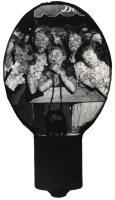The first known photographic image of the forest of Fontainebleau (French: Forêt de Fontainebleau, or Forêt de Bière, meaning “forest of heather”—lying sixty kilometers southeast of Paris) is a daguerreotype by an anonymous photographer from around 1845, which can be found in the collection of Musée d’Orsay in Paris. It reminds us how rapidly photographers came to join the Barbizon School of painters who, since the development of painting in the open air, invaded the forest of Fontainebleau to work directly from nature. While giving rise to hundreds works of art—followed by the Impressionists in the 1860s—they turned the forest into the most popular site in the art world throughout the nineteenth century.

Probably by W.H. Harrison, [Forêt de Fontainebleau], 1870s (83.1999)
As soon as photographs were being produced on paper—a more suitable process for shooting pictures outside—the dialogue between the new medium of photography and painting began to take place in the forest of Fontainebleau. When the railway arrived, the forest became more accessible and Gustave Le Gray, a photographer trained as a painter, found his way in 1849; he was the first to significantly improve the paper negative and emphasize all its aesthetic potential.

Eugène Cuvelier, Pres de Carrefour de l’Epine, 1860s (2010.118.8)
Instead of carrying his paint box and easel, landscape photographer Eugène Cuvelier took his camera through the streets of Barbizon and along the trees of the forest of Fontainebleau. His carefully composed and richly printed photographs show similarities with the pre-Impressionist paintings of his painting friends from the Barbizon School with who he shared an aesthetic milieu: while Cuvelier was drawing inspiration from the paintings by Jean-Baptiste-Camille Corot, Théodore Rousseau, Jean-François Millet and others; his photographs contributed to their vision and influenced the painters.

Eugène Cuvelier, Pres de Carrefour de l’Epine, 1860s (2010.118.5)
While most of his work is made in his beloved forest and home in Barbizon, Cuvelier’s photographs shown here are made in the forest of Carrefour de l’Épinette, in the northwest of France. The image below pictures the river in Moret-sur-Loing, on the other side of Fontainebleau. These three photographs reveal the same intimate aspect that we recognize in the photographs of the forest of Fontainebleau and are imbued with the reserved silent poetry that we can find in his still lives and portraits of his city.

Eugène Cuvelier, Rivière au Loing a Moret, 1860s (2010.118.7)
Eugène Atget, who was interested in places with historical associations and did several landscape studies, arrived at the forest in the end of the nineteenth century, making photographs of the Château of Fontainebleau and its surroundings.

Eugène Atget, Fontainebleau, Cavalière des Brigands, ca. 1898-1927 (2009.79.12)

